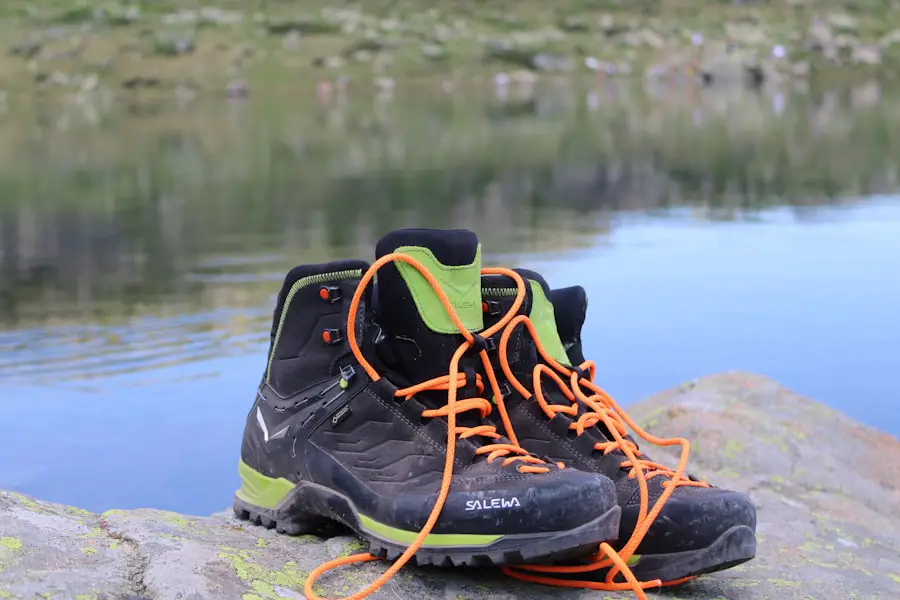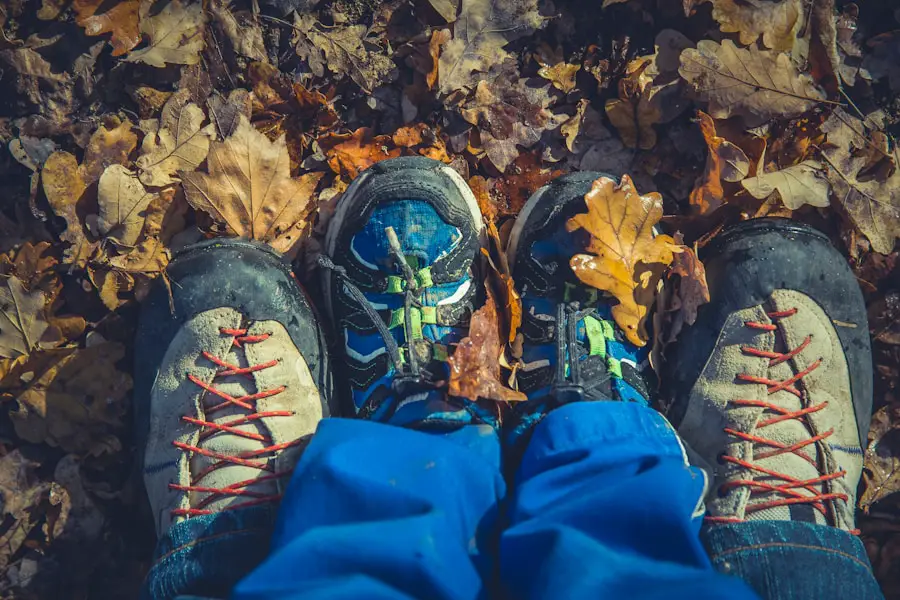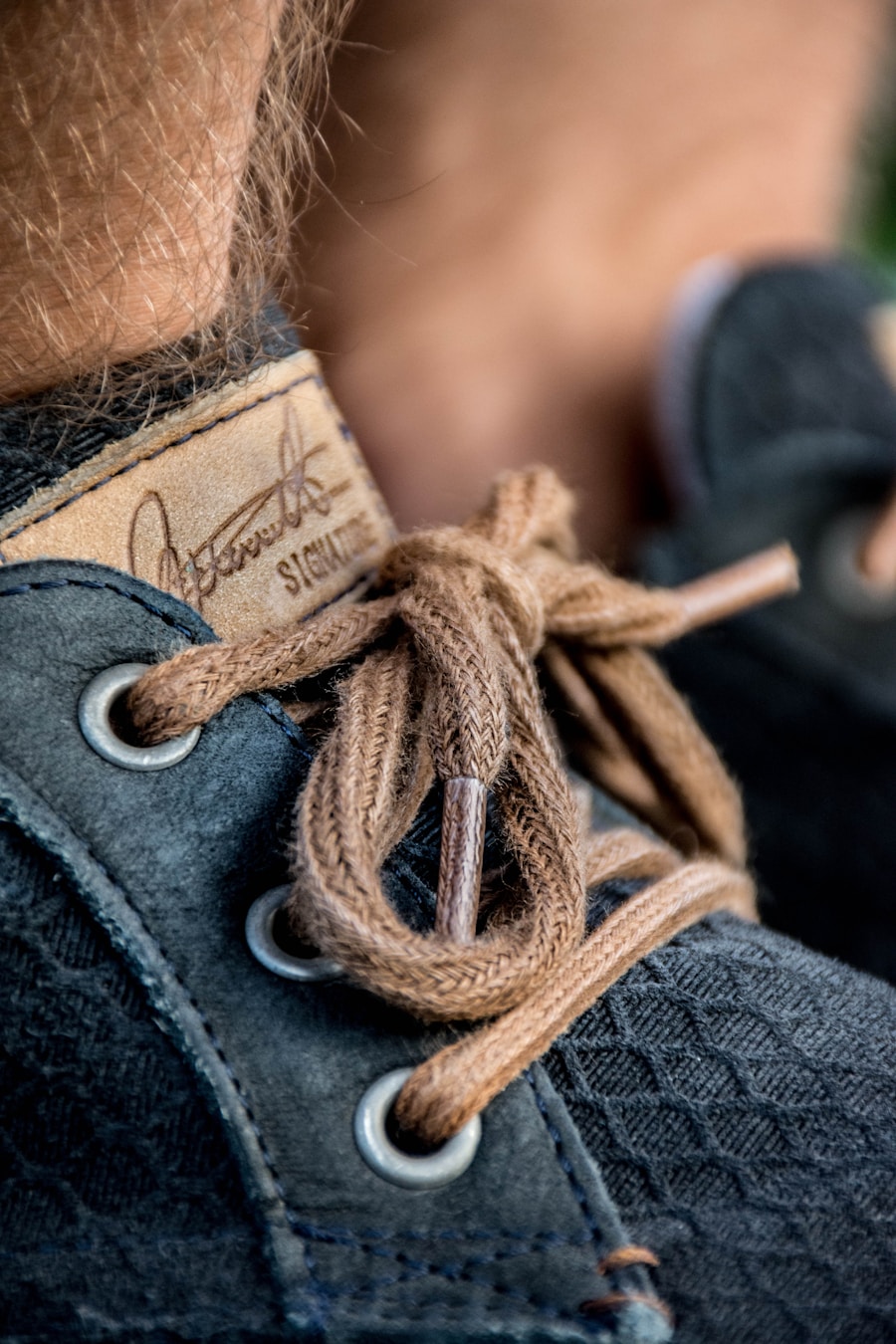Proper lacing techniques are fundamental to achieving comfort and performance in any footwear, particularly in hiking shoes. The way a shoe is laced can significantly affect how it fits, how it feels during movement, and how well it supports the foot. When laces are too tight, they can create pressure points that lead to discomfort, while laces that are too loose can result in instability, causing the foot to slide within the shoe.
This instability can lead to blisters, loss of traction, and even injuries, especially on uneven terrain. Therefore, understanding the nuances of lacing is essential for anyone who spends extended periods on their feet, particularly in challenging environments. Moreover, proper lacing techniques can enhance the overall performance of hiking shoes.
A well-laced shoe allows for better energy transfer during each step, which is crucial when navigating steep inclines or rocky paths. The right lacing can also help in distributing pressure evenly across the foot, reducing fatigue and allowing hikers to maintain their stamina over long distances. In essence, mastering lacing techniques is not merely a matter of comfort; it is a critical component of effective hiking that can influence the overall experience on the trail.
Key Takeaways
- Proper lacing techniques are important for achieving a secure and comfortable fit with your hiking shoes.
- Different lacing patterns should be used for different foot types to prevent discomfort and injury.
- To prevent blisters and hotspots, it’s important to adjust lacing techniques and use proper socks.
- Achieving a secure fit with your hiking shoes is crucial for stability and preventing foot injuries on the trail.
- Adjusting lacing for uphill and downhill terrain can provide better support and prevent foot slippage.
Understanding Different Lacing Patterns for Different Foot Types
Different foot types require different lacing patterns to achieve optimal fit and comfort. For instance, individuals with high arches may benefit from a lacing technique that provides additional support around the arch area. A common approach for high-arched feet is to use a “skip lacing” method, where certain eyelets are skipped to create more space and reduce pressure on the top of the foot.
This technique allows for a more customized fit that accommodates the unique shape of high-arched feet while still providing adequate support. Conversely, those with flat feet may require a tighter fit across the midfoot to prevent excessive movement within the shoe. A “heel lock” or “lace lock” technique can be particularly beneficial for flat-footed individuals.
This method involves threading the lace through the top two eyelets in a way that creates a loop before pulling the lace tight. This not only secures the heel in place but also helps to stabilize the foot within the shoe, reducing the risk of blisters and enhancing overall comfort during hikes.
Tips for Preventing Blisters and Hotspots

Blisters and hotspots are common issues faced by hikers, often resulting from friction between the foot and the shoe. To prevent these painful occurrences, it is essential to focus on both lacing techniques and sock choice. One effective strategy is to ensure that laces are tightened appropriately without being overly constrictive.
A snug fit helps keep the foot in place, minimizing movement that can lead to friction. Additionally, using moisture-wicking socks made from synthetic materials can help reduce sweat accumulation, which is a significant contributor to blister formation. Another preventive measure involves paying attention to specific areas of the foot that are prone to hotspots.
For example, if you know that your heels tend to rub against the back of your shoes, consider using a heel lock lacing technique to secure your heel more effectively. Furthermore, applying blister prevention products such as blister pads or specialized anti-chafing balms can provide an extra layer of protection against friction. By combining thoughtful lacing techniques with appropriate gear choices, hikers can significantly reduce their risk of developing blisters and hotspots on the trail.
How to Achieve a Secure Fit with Your Hiking Shoes
| Factors | Metrics |
|---|---|
| Proper Sizing | Measure your feet and choose the right size according to the manufacturer’s sizing chart |
| Lacing Techniques | Experiment with different lacing techniques such as heel lock or surgeon’s knot to achieve a secure fit |
| Ankle Support | Look for hiking shoes with ankle support features such as padded collars or high-cut designs |
| Toe Box Fit | Ensure there is enough room for your toes to wiggle without being too loose or too tight |
| Terrain Specificity | Choose hiking shoes with the appropriate level of stiffness and traction for the specific terrain you will be hiking on |
Achieving a secure fit with hiking shoes is crucial for both comfort and performance. A secure fit begins with selecting the right size and style of shoe for your foot type. Once you have chosen your footwear, proper lacing becomes essential in ensuring that the shoe fits snugly without causing discomfort.
Start by loosening all the laces before putting on your shoes; this allows for easier entry and helps you adjust the fit more effectively once your foot is inside. After securing your foot in the shoe, begin lacing from the bottom up, ensuring that each eyelet is tightened evenly. Pay special attention to the midfoot area; this is where many hikers experience slippage if not properly secured.
If you find that your heel lifts when walking or climbing, consider using a heel lock technique at the top eyelets to create additional tension and keep your heel firmly in place. A secure fit not only enhances comfort but also improves stability on uneven terrain, allowing for a more enjoyable hiking experience.
Adjusting Lacing for Uphill and Downhill Terrain
The terrain you encounter while hiking can greatly influence how you should lace your shoes. When ascending steep inclines, it is beneficial to adjust your lacing to provide extra support and prevent your foot from sliding forward in the shoe. One effective method is to tighten the laces more around the forefoot and midfoot areas while leaving the top eyelets slightly looser.
This adjustment allows for better control and stability as you navigate upward slopes while still providing enough flexibility at the ankle. Conversely, when descending downhill, it is crucial to ensure that your heel remains locked in place to prevent it from sliding forward and causing discomfort or injury. In this case, consider using a tighter lacing technique throughout the entire shoe, particularly around the ankle area.
This will help keep your foot securely positioned within the shoe as you navigate downward slopes, reducing the risk of blisters and enhancing overall control during descents. By adjusting your lacing according to terrain changes, you can significantly improve your hiking experience.
Utilizing Lock Lacing for Added Stability

Lock lacing is a technique that provides added stability and security for hikers who require extra support during their treks. This method involves creating a locking mechanism at the top of the shoe by threading the lace through the last two eyelets in a specific way. By forming a loop with each lace before pulling it tight, you create a secure hold that prevents any unwanted movement of the heel within the shoe.
This technique is particularly beneficial for those who engage in challenging hikes or carry heavy backpacks, as it helps maintain proper alignment of the foot within the shoe. Lock lacing not only enhances stability but also reduces fatigue by allowing for better energy transfer during each step. Hikers who frequently traverse rocky or uneven terrain will find this technique invaluable in maintaining control and comfort throughout their journey.
Customizing Lacing Techniques for Specific Hiking Activities
Different hiking activities may require unique lacing techniques tailored to specific needs. For instance, if you are planning a long-distance hike or backpacking trip, comfort becomes paramount. In such cases, consider using a more relaxed lacing pattern that allows for slight movement within the shoe while still providing adequate support.
This approach can help prevent fatigue over extended periods of walking. On the other hand, if you are engaging in technical climbing or scrambling where precision and control are essential, a tighter lacing technique may be necessary. In these situations, ensuring that every part of your foot is securely held in place will enhance your ability to navigate challenging obstacles safely.
By customizing your lacing techniques based on the specific demands of your hiking activity, you can optimize both comfort and performance.
Troubleshooting Common Lacing Issues on the Trail
Even with careful attention to lacing techniques, hikers may encounter common issues while on the trail. One frequent problem is loosening laces during hikes, which can lead to discomfort and instability. To address this issue, consider using lace locks or double-knotting your laces before setting out on your journey.
These methods help keep your laces securely fastened throughout your hike. Another common issue is uneven pressure distribution across different areas of the foot, which can lead to discomfort or pain during long hikes. If you notice specific areas feeling tight or constricted, take a moment to adjust your laces accordingly.
Loosening certain sections while tightening others can help create a more balanced fit that accommodates your foot’s natural shape and movement patterns. By being proactive about troubleshooting these common lacing issues, hikers can ensure a more enjoyable and pain-free experience on their adventures.
If you’re looking for tips on how to properly lace your hiking shoes, you may also be interested in reading about the “5 Must-Have Portable Camping Stoves for Your Spring 2025 Adventures” on TakeTravelInfo. Having the right gear for your outdoor excursions is essential, and a reliable camping stove can make all the difference in your cooking experience while on the trail. Check out the article here for recommendations on top-rated portable camping stoves to enhance your camping trips.
Love travel? Join Our Facebook Community For More Tips.
FAQs
What are the benefits of lacing hiking shoes properly?
Properly lacing hiking shoes can provide better support, prevent blisters, and improve overall comfort during long hikes.
What is the best lacing technique for hiking shoes?
The best lacing technique for hiking shoes is the “heel lock” or “lace lock” method, which helps to prevent heel slippage and provides a secure fit.
How do you lace hiking shoes to prevent blisters?
To prevent blisters, it’s important to lace hiking shoes snugly but not too tight, and to use techniques such as the “heel lock” to prevent excessive movement and friction.
Are there different lacing techniques for different types of hiking shoes?
Yes, there are different lacing techniques for different types of hiking shoes, such as low-cut trail shoes, mid-cut hiking boots, and high-cut mountaineering boots.
Can lacing hiking shoes improperly cause foot pain?
Yes, lacing hiking shoes improperly can cause foot pain, as it can lead to inadequate support, excessive movement, and pressure points that can result in discomfort and pain.
